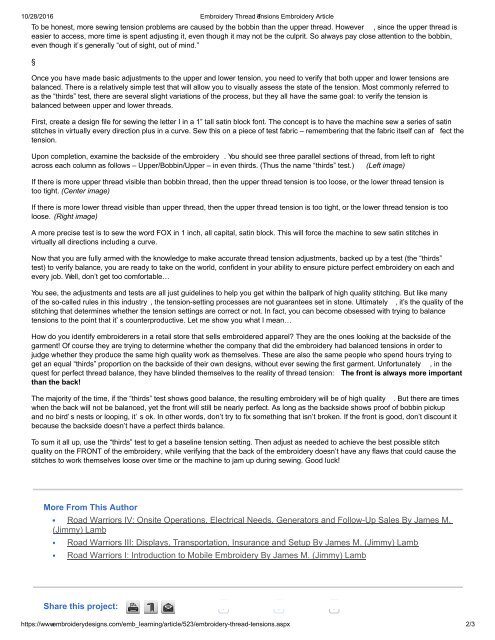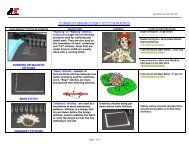Compiled Embroidery Skill Articles
You also want an ePaper? Increase the reach of your titles
YUMPU automatically turns print PDFs into web optimized ePapers that Google loves.
10/28/2016 <strong>Embroidery</strong> Thread Tensions <strong>Embroidery</strong> Article<br />
To be honest, more sewing tension problems are caused by the bobbin than the upper thread. However , since the upper thread is<br />
easier to access, more time is spent adjusting it, even though it may not be the culprit. So always pay close attention to the bobbin,<br />
even though it’s generally “out of sight, out of mind.”<br />
§<br />
Once you have made basic adjustments to the upper and lower tension, you need to verify that both upper and lower tensions are<br />
balanced. There is a relatively simple test that will allow you to visually assess the state of the tension. Most commonly referred to<br />
as the “thirds” test, there are several slight variations of the process, but they all have the same goal: to verify the tension is<br />
balanced between upper and lower threads.<br />
First, create a design file for sewing the letter I in a 1” tall satin block font. The concept is to have the machine sew a series of satin<br />
stitches in virtually every direction plus in a curve. Sew this on a piece of test fabric – remembering that the fabric itself can af fect the<br />
tension.<br />
Upon completion, examine the backside of the embroidery . You should see three parallel sections of thread, from left to right<br />
across each column as follows – Upper/Bobbin/Upper – in even thirds. (Thus the name “thirds” test.) (Left image)<br />
If there is more upper thread visible than bobbin thread, then the upper thread tension is too loose, or the lower thread tension is<br />
too tight. (Center image)<br />
If there is more lower thread visible than upper thread, then the upper thread tension is too tight, or the lower thread tension is too<br />
loose. (Right image)<br />
A more precise test is to sew the word FOX in 1 inch, all capital, satin block. This will force the machine to sew satin stitches in<br />
virtually all directions including a curve.<br />
Now that you are fully armed with the knowledge to make accurate thread tension adjustments, backed up by a test (the “thirds”<br />
test) to verify balance, you are ready to take on the world, confident in your ability to ensure picture perfect embroidery on each and<br />
every job. Well, don’t get too comfortable…<br />
You see, the adjustments and tests are all just guidelines to help you get within the ballpark of high quality stitching. But like many<br />
of the socalled rules in this industry , the tensionsetting processes are not guarantees set in stone. Ultimately , it’s the quality of the<br />
stitching that determines whether the tension settings are correct or not. In fact, you can become obsessed with trying to balance<br />
tensions to the point that it’ s counterproductive. Let me show you what I mean…<br />
How do you identify embroiderers in a retail store that sells embroidered apparel? They are the ones looking at the backside of the<br />
garment! Of course they are trying to determine whether the company that did the embroidery had balanced tensions in order to<br />
judge whether they produce the same high quality work as themselves. These are also the same people who spend hours trying to<br />
get an equal “thirds” proportion on the backside of their own designs, without ever sewing the first garment. Unfortunately , in the<br />
quest for perfect thread balance, they have blinded themselves to the reality of thread tension: The front is always more important<br />
than the back!<br />
The majority of the time, if the “thirds” test shows good balance, the resulting embroidery will be of high quality . But there are times<br />
when the back will not be balanced, yet the front will still be nearly perfect. As long as the backside shows proof of bobbin pickup<br />
and no bird’ s nests or looping, it’ s ok. In other words, don’t try to fix something that isn’t broken. If the front is good, don’t discount it<br />
because the backside doesn’t have a perfect thirds balance.<br />
To sum it all up, use the “thirds” test to get a baseline tension setting. Then adjust as needed to achieve the best possible stitch<br />
quality on the FRONT of the embroidery, while verifying that the back of the embroidery doesn’t have any flaws that could cause the<br />
stitches to work themselves loose over time or the machine to jam up during sewing. Good luck!<br />
More From This Author<br />
Road Warriors IV: Onsite Operations, Electrical Needs, Generators and FollowUp Sales By James M.<br />
(Jimmy) Lamb<br />
Road Warriors III: Displays, Transportation, Insurance and Setup By James M. (Jimmy) Lamb<br />
Road Warriors I: Introduction to Mobile <strong>Embroidery</strong> By James M. (Jimmy) Lamb<br />
Share this project: 0 0 0<br />
https://www.embroiderydesigns.com/emb_learning/article/523/embroiderythreadtensions.aspx 2/3




